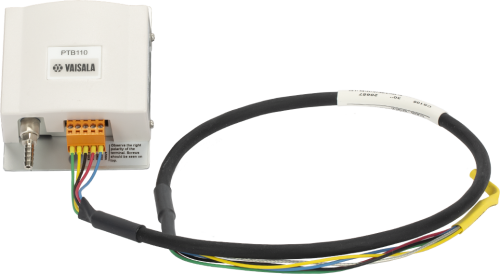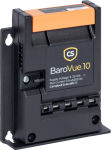
Incluye control encendido/apagado para optimizar consumo






Resumen
El CS106 mide la presión barométrica entre 500 a 1100 mb. Diseñado para aplicaciones mediambientales, el CS106 es compatible con todos nuestros dataloggers Campbell Scientific.
Leer másVentajas y características
- Adecuado para montar en armarios Campbell Scientific
- Un circuito de conmutación integrado limita el consumo de energía al ciclo de medición
- 3 años de garantía
Imágenes



Descripción detallada
El CS106 utiliza el sensor capacitivo Vaisala BAROCAP para medir la presión barométrica. Está montado dentro de una carcasa de plástico (ABS/PC blend) e incluye una válvula de entrada de aire para el equilibrado de presión.
La salida eléctrica es lineal de 0 a 2.5 Vdc, lo cual permite que el barómetro pueda conectarse directamente a un datalogger Campbell Scientific. Dispone de una circuitería interna que permite que el datalogger alimente el sensor solo durante la medida, reduciendo el consumo de energía.
Productos similares
Preguntas frecuentes
Número de FAQs relacionadas con CS106: 12
Expandir todoDesplegar todo
-
The sensor plug on the CS106 is the same as the one on the CS105. If the cable and connections are still working correctly, it should be possible to power down the station and swap out the sensors without any difficulty.
-
The CS106 is not a direct replacement. To use a CS106 in a system that previously used a CS105, the multiplier and offset will need to be changed in the program. Because the CS106 has a longer warm-up time, if the sensor is turned on and off, it may be necessary to make some adjustments to the warm-up time.
-
Noisy measurements may be caused by several factors:
- The sensor was not allowed to warm up adequately.
- The sensor is placed in an electrically noisy environment, which makes other analog measurements noisy.
- The power supply for the sensor or station is dirty. (There is not a clean regulated voltage.)
-
Yes, but only if certain conditions are met:
- The sensor resides in a non-condensing environment.
- The vent tube accessing the high humidity environment is extremely well desiccated to keep any moisture from reaching the sensor’s components. Moisture in the sensor will damage the sensor, often to an un-repairable state.
-
Either the CS100 or the CS106 can fit inside an ENC100. For more information, refer to the Specifications information on the ENC100 product page.
-
In most cases, enclosures and buildings have enough little spaces for the pressure to stay at equilibrium with the outside pressure. Therefore, the sensor does not need to be vented to the outside. It is possible, however, that the rate at which the pressure equalizes is slowed by being in an enclosure, but the rate change usually is not noticeably significant.
If the sensor resides in an absolutely air-tight environment, and the pressure outside this environment needs to be measured, then the sensor will need to be vented to the outside. However, venting to the outside may change the rating of the enclosure or associated inside environment.
-
For a reading in millibars, the multiplier is 0.240, and the offset is 500. To convert the millibar reading to different units, add an equation to the code.
To correct the pressure to sea level, see the “Correcting Pressure to Sea Level” section in the CS100 instruction manual or in the CS106 instruction manual. Alternatively, use Short Cut for Windows to generate the program, and, when prompted, enter the appropriate site elevation.
-
The manufacturer recommends calibration on a yearly basis. However, conformance to published standards or regulations may require this on a more frequent basis.
-
Generally, these sensors are designed to measure the pressure of the environment where they are installed. The CS100 or CS106 can measure the air pressure within a snowpack if the enclosure is adequately sealed away from the snow while allowing the vent to have access to the snow. Note that it may be difficult to accomplish this.
Compatibilidad
Nota: lo siguiente muestra información de compatibilidad notable. No es una lista de todos los productos compatibles.
Dataloggers
| Producto | Compatible | Nota |
|---|---|---|
| CR1000 (retired) | ||
| CR300 (retired) | ||
| CR3000 (retired) | ||
| CR310 | ||
| CR350 | ||
| CR6 | ||
| CR800 (retired) | ||
| CR850 (retired) |
Información de compatibilidad adicional
Data Logger Considerations
A 2.5-ft cable is supplied with the sensor for connection to the data logger. The cable connects to a control port, single-ended analog input terminal, 12 V power terminal, and ground terminal on the data logger.
Mounting
The CS106 is typically mounted next to the data logger inside an ENC12/14 or larger enclosure. The very small ENC100 is available for housing the CS106 separately, in its own enclosure.
Especificaciones
| -NOTE- | 1 hPa = 1 mBar |
| Pressure Range | 500 to 1100 hPa |
| Long-Term Stability | ± 0.1 hPa per year |
| Settling Time | 1 s to reach full accuracy after power-up |
| Response Time | 500 ms to reach full accuracy after a pressure step |
| Output Voltage | 0 to 2.5 Vdc |
| Supply Voltage | 10 to 30 Vdc |
| Elevation | ~609.6 m (2,000 ft) below sea level (as in a mine) to 4,572 m (15,000 ft) above sea level |
| Accuracy |
|
| Linearity | ±0.25 hPa |
| Hysteresis | ±0.03 hPa |
| Repeatability | ±0.03 hPa |
| Calibration Uncertainty | ±0.15 hPa |
| Current Consumption |
|
| Temperature Range | -40° to +60°C |
| Dimensions | 6.8 x 9.7 x 2.8 cm (2.7 x 3.8 x 1.1 in.) |
| Cable Length | 76.2 cm (30 in.) |
| Weight | 90 g (3.2 oz) |
Documentos
Folletos producto
Manuales
Casos de aplicación
Southwestern South Africa had three consecutive dry winters—from 2015 through 2017—resulting in the Cape Town......leer más
Currently, the Andean tropical glaciers are in an accelerated process of retreat. These glaciers are......leer más
The past few years have seen a scramble within the power industry to use more......leer más
In a country as large as Argentina, monitoring growing conditions in different agricultural regions is......leer más






